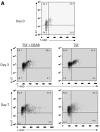Inhibition of aldehyde dehydrogenase expands hematopoietic stem cells with radioprotective capacity
- PMID: 20054864
- PMCID: PMC3909217
- DOI: 10.1002/stem.299
Inhibition of aldehyde dehydrogenase expands hematopoietic stem cells with radioprotective capacity
Abstract
Hematopoietic stem cells (HSCs) are enriched for aldehyde dehydrogenase (ALDH) activity and ALDH is a selectable marker for human HSCs. However, the function of ALDH in HSC biology is not well understood. We sought to determine the function of ALDH in regulating HSC fate. Pharmacologic inhibition of ALDH with diethylaminobenzaldehyde (DEAB) impeded the differentiation of murine CD34(-)c-kit(+)Sca-1(+)lineage(-) (34(-)KSL) HSCs in culture and facilitated a ninefold expansion of cells capable of radioprotecting lethally irradiated mice compared to input 34(-)KSL cells. Treatment of bone marrow (BM) 34(-)KSL cells with DEAB caused a fourfold increase in 4-week competitive repopulating units, verifying the amplification of short-term HSCs (ST-HSCs) in response to ALDH inhibition. Targeted siRNA of ALDH1a1 in BM HSCs caused a comparable expansion of radioprotective progenitor cells in culture compared to DEAB treatment, confirming that ALDH1a1 was the target of DEAB inhibition. The addition of all trans retinoic acid blocked DEAB-mediated expansion of ST-HSCs in culture, suggesting that ALDH1a1 regulates HSC differentiation via augmentation of retinoid signaling. Pharmacologic inhibition of ALDH has therapeutic potential as a means to amplify ST-HSCs for transplantation purposes.
Figures







Similar articles
-
Inhibition of aldehyde dehydrogenase and retinoid signaling induces the expansion of human hematopoietic stem cells.Proc Natl Acad Sci U S A. 2006 Aug 1;103(31):11707-12. doi: 10.1073/pnas.0603806103. Epub 2006 Jul 20. Proc Natl Acad Sci U S A. 2006. PMID: 16857736 Free PMC article.
-
Inhibition of Retinoic Acid Production Expands a Megakaryocyte-Enriched Subpopulation with Islet Regenerative Function.Stem Cells Dev. 2018 Oct 15;27(20):1449-1461. doi: 10.1089/scd.2018.0111. Epub 2018 Sep 5. Stem Cells Dev. 2018. PMID: 30039749
-
Distinct expression patterns and roles of aldehyde dehydrogenases in normal oral mucosa keratinocytes: differential inhibitory effects of a pharmacological inhibitor and RNAi-mediated knockdown on cellular phenotype and epithelial morphology.Histochem Cell Biol. 2013 Jun;139(6):847-62. doi: 10.1007/s00418-012-1064-7. Epub 2012 Dec 19. Histochem Cell Biol. 2013. PMID: 23250514
-
Quantitative assessment of the stem cell self-renewal capacity.Ann N Y Acad Sci. 2001 Jun;938:18-24; discussion 24-5. doi: 10.1111/j.1749-6632.2001.tb03570.x. Ann N Y Acad Sci. 2001. PMID: 11458506 Review.
-
Aldehyde dehydrogenase 1A1 and 1A3 isoforms - mechanism of activation and regulation in cancer.Cell Signal. 2021 Nov;87:110120. doi: 10.1016/j.cellsig.2021.110120. Epub 2021 Aug 21. Cell Signal. 2021. PMID: 34428540 Free PMC article. Review.
Cited by
-
Aldehyde dehydrogenase 1A1--a new mediator of resistance to temozolomide in glioblastoma.Neuro Oncol. 2012 Dec;14(12):1452-64. doi: 10.1093/neuonc/nos270. Epub 2012 Nov 6. Neuro Oncol. 2012. PMID: 23132408 Free PMC article.
-
Targeting cancer stem cells with p53 modulators.Oncotarget. 2016 Jul 19;7(29):45079-45093. doi: 10.18632/oncotarget.8650. Oncotarget. 2016. PMID: 27074569 Free PMC article.
-
Activity-Based Bioluminescent Logic-Gate Probe Reveals Crosstalk Between the Inflammatory Tumor Microenvironment and ALDH1A1 in Cancer Cells.JACS Au. 2024 Dec 28;5(1):320-331. doi: 10.1021/jacsau.4c01001. eCollection 2025 Jan 27. JACS Au. 2024. PMID: 39886570 Free PMC article.
-
All-trans retinoic acid in non-promyelocytic acute myeloid leukemia: driver lesion dependent effects on leukemic stem cells.Cell Cycle. 2020 Oct;19(20):2573-2588. doi: 10.1080/15384101.2020.1810402. Epub 2020 Sep 8. Cell Cycle. 2020. PMID: 32900260 Free PMC article. Review.
-
Detection of metastatic tumors after γ-irradiation using longitudinal molecular imaging and gene expression profiling of metastatic tumor nodules.Int J Oncol. 2016 Apr;48(4):1361-8. doi: 10.3892/ijo.2016.3384. Epub 2016 Feb 8. Int J Oncol. 2016. PMID: 26892334 Free PMC article.
References
-
- Laughlin MJ, Eapen M, Rubinstein P, et al. Outcomes after transplantation of cord blood or bone marrow from unrelated donors in adults with leukemia. N Engl J Med. 2004;351:2265–2275. - PubMed
-
- Cornelissen JJ, Lowenberg B. Role of allogeneic stem cell transplantation in current treatment of acute myeloid leukemia. Hematology Am Soc Hematol Educ Program. 2005:151–155. - PubMed
-
- Alyea EP, Kim HT, Ho V, et al. Impact of conditioning regimen intensity on outcome of allogeneic hematopoietic cell transplantation for advanced acute myelogenous leukemia and myelodysplastic syndrome. Biol Blood Marrow Transplant. 2006;12:1047–1055. - PubMed
-
- Meijer E, Dekker AW, Lokhorst HM, et al. Low incidence of infectious complications after nonmyeloablative compared with myeloablative allogeneic stem cell transplantation. Transpl Infect Dis. 2004;6:171–178. - PubMed
-
- Barker JN. Umbilical Cord Blood (UCB) Transplantation: An Alternative to the Use of Unrelated Volunteer Donors? Hematology Am Soc Hematol Educ Program. 2007:55–61. - PubMed
Publication types
MeSH terms
Substances
Grants and funding
LinkOut - more resources
Full Text Sources
Other Literature Sources
Medical
Research Materials
Miscellaneous

